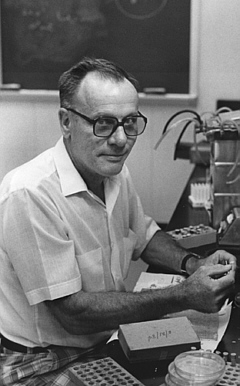
News Release
|
Office of News and Information Johns Hopkins University 3003 N. Charles Street, Suite 100 Baltimore, Maryland 21218-3843 Phone: (410) 516-7160 | Fax (410) 516-5251 |
May 13, 2003 FOR IMMEDIATE RELEASE CONTACT: Michael Purdy mcp@jhu.edu (410) 516-7906 |
Philip E. Hartman, professor emeritus of biology in the Krieger School of Arts and Sciences and a pioneer in microbial genetics and mutagenesis, a process essential to understanding the development of cancer, has died.
 Hartman, who was 76, died on May 4 of cancer.
Colleagues and former students remembered him as an
outstanding researcher and mentor who was dedicated to a
variety of causes outside the classroom, including
environmental protection and cleanup, increased minority
enrollment, and the
Johns
Hopkins Tutorial Project, a program that lets Johns
Hopkins students tutor Baltimore city school children.
Hartman, who was 76, died on May 4 of cancer.
Colleagues and former students remembered him as an
outstanding researcher and mentor who was dedicated to a
variety of causes outside the classroom, including
environmental protection and cleanup, increased minority
enrollment, and the
Johns
Hopkins Tutorial Project, a program that lets Johns
Hopkins students tutor Baltimore city school children.
Hartman was born on November 23, 1926 in Baltimore. He served as a radioman in the U.S. Navy during World War II, and earned his Ph.D. in microbiology at the University of Pennsylvania in 1953.
Hartman came to Johns Hopkins in 1957 as an assistant professor of biology after fellowships with the National Cancer Institute and the American Cancer Society. He became a professor of biology in 1965, and was named William D. Gill professor of biology in 1975.
"He was noted for seminal work he did on a metabolic pathway involving the histidine operon," recalled Maurice Bessman, professor of biology. "His early collaboration with Bruce Ames helped lead to the development of the Ames test, which is one of the most prominent tests for the screening of potential carcinogens."
"Phil was a wonderful teacher, human being, and guy to talk science with," said Andrew Hoyt, professor of biology. "He could express to a class in 3 words what would take me 300. He was great in making complicated concepts very simple."
Gene Action, a 1965 textbook written by Hartman and fellow Hopkins faculty member Sigmund Suskind, became popular as a basic college-level genetics textbook and was translated into several languages.
Hartman published more than 200 scientific papers, and was a member, among other organizations, of the American Society for Microbiology, the Genetics Society of America, The Environmental Mutagen Society, and the American Association for Cancer Research. His awards included the 1985 Environmental Mutagen Society Award for research into mutagenesis and its effects on human health.
Former Hartman student James Wyche, now vice provost and dean of the College of Arts and Sciences at the University of Miami, remembered his mentor as a man dedicated to enhancing educational opportunities for minorities. Hartman recruited Wyche, an African-American, to come to Hopkins after meeting him at Cold Spring Harbor Laboratory. He also provided encouragement and support when Wyche created a group of Johns Hopkins minority students who traveled to southern universities to interest more minority students in coming to Johns Hopkins.
"His commitment to quality education for all was more than just words -- he demonstrated it in deeds as well," Wyche remembered. "We [went recruiting at southern universities] four or five times, and he went out on the road every time with us, driving his vehicle around with us to places helping us to recruit."
Hartman campaigned actively against chemical and biological weapons research, and had letters published in the Baltimore Sun and the New York Times critical of the enormous budgetary resources given to such projects and other defense work. He was also active in the environmental movement. He was frequently involved in stream clearance projects, served on the Maryland Conservation Council, and was a co-founder of the Assateaque Coastal Trust, an organization dedicated to the preservation of Assateaque Island.
"He had a great social conscience, and he quietly did a lot of great things," remembered Chester Wickwire, a former chaplain at Johns Hopkins who retired in 1984. Wickwire and Hartman were involved in the creation in 1958 of the JHU Tutorial Project, a program still active today that matches Johns Hopkins students up with inner city students in need of academic tutoring. In its early years, the program was run from a University YMCA on the Johns Hopkins campus that bussed Johns Hopkins students into the inner city to work with high school students.
"Phil was such a solid guy -- he did things quietly, but he did them, so you knew that you could count on him all the time," Wickwire recalled. "In trying to relate the campus to the city, Phil was really there with us all the way. He gave us total support of what we were doing, advised us, and helped to keep us alive there on the campus."
Today, the Tutorial Project brings elementary students twice weekly to campus for tutoring from Johns Hopkins students.
Private funeral services will be held in June. Hartman is survived by his wife of 48 years, Zlata Hartman; sons Paul Hartman, of Baltimore, and Fred Hartman, of Potomac; daughter Sherry Apgar of Ewing, NJ; and seven grandchildren. The family encourages memorial donations to the JHU Tutorial Project, attention: Bill Tiefenwerth, c/o Center for Community Relations and Volunteer Services, Levering Hall Suite 200, 3400 N. Charles St., Baltimore, MD, 21218.
|
Johns Hopkins University news releases can be found on the
World Wide Web at
http://www.jhu.edu/news_info/news/ Information on automatic e-mail delivery of science and medical news releases is available at the same address.
|
 Go to
Headlines@HopkinsHome Page
Go to
Headlines@HopkinsHome Page